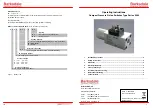
Switch/shutter actuator 8/4gang 16A RMD
75318003
Switch/shutter actuator 16/8gang 16A
RMD
75310002
Technical
Documentation
© Berker GmbH & Co KG 2007
Version: 04.04.2007
Part 5
(Subject to prior change)
75310002.doc
Seite: 78 / 174
Example 2…
The shutter connected to a certain output has an overall travelling time of 20 s. The shutter is in the 25 %
position. It is to be positioned at 75 %. The difference between the positions is 50 %. The actuator
calculates the travelling time required for bridging the difference between the positions: 20 s
⋅
0.5
(50 %)
= 10
s. The output will then lower the shutter for 10 s and thus position the shutter curtain at height of 75 %.
For all upward travels, the travelling time extension parameterized or determined by end position detection
will automatically be added to the travelling time calculated.
Example 3…
The shutter connected to a certain output has an overall travelling time of 20 s. The shutter is in the 75 %
position. It is to be positioned at 25 %. The difference between the positions is 50 %. The actuator
calculates the travelling time without extension required for bridging the difference between the positions:
20 s
⋅
0.5
(50 %)
= 10 s. Taking the travelling time extension into account (e.g. 10 %), the actual raising time is:
10 s
⋅
((100 % + 10 %
(extension)
)
:
100 %) = 10 s
⋅
1,1 = 11 s.
The output will then raise the shutter for 11 s and thus position the shutter curtain at a height of 25 %.
When the lower or upper end positions (0 % or 100 %) are approached, the travelling time is always 20 %
longer than the overall travelling time.
Example 4…
The shutter connected to a certain output has an overall travelling time of 20 s. The shutter is in the 50 %
position. It is to be positioned at 100 %. The difference between the positions is 50 %. The actuator
calculates the travelling time required for bridging the difference between the positions: 20 s
⋅
0.5
(50 %)
= 10
s. As the travel is a travel into an end position, the actuator adds a fixed percentage corresponding to 20 %
of the overall travelling time.
10 s + (20 %
:
100 %)
⋅
20 s = 14 s. The output will then lower the shutter for 14 s and thus position the
shutter curtain safely at height of 100 %.
Example 5…
The shutter connected to a certain output has an overall travelling time of 20 s. The shutter is in the 50 %
position. It is to be positioned at 0 %. The difference between the positions is 50 %. The actuator calculates
the travelling time without extension required for bridging the difference between the positions:
20 s
⋅
0.5
(50 %)
= 10 s. As the travel is a travel into an end position, the actuator adds a fixed percentage
corresponding to 20 % of the overall travelling time. 10 s + (20 %
:
100 %)
⋅
20 s = 14 s.
Taking the travelling time extension into account (e.g. 10 %), the actual raising time is: 14 s
⋅
((100 % + 10
%
(extension)
)
:
100 %) = 14 s
⋅
1.1 = 15.4 s. The output will then raise the shutter for 15.4 s and thus position
the shutter curtain safely at a height of 0 %.
The switching/shutter actuator executes position approaches only if a new position deviating from the
current position is preset.
The switching/shutter actuator stores the blind/shutter/awning or louver positions temporarily. The shutter
actuator can approach newly preset blind/shutter/awning or louver positions only if the current positions
are known. For this purpose, each output must be given the opportunity to synchronize itself whenever
the supply voltage is switched on or after every ETS programming (physical address, application
program, partial download). The synchronization is performed with the help of a reference travel (cf.
"Reference travel").
Position approaches in progress will be aborted in case of bus or mains voltage failure. In case of bus
voltage failure, the parameterized behaviour will be executed. In case of mains failure, the drives will be
stopped. Position approaches are also interrupted when the manual control mode is activated.
















































